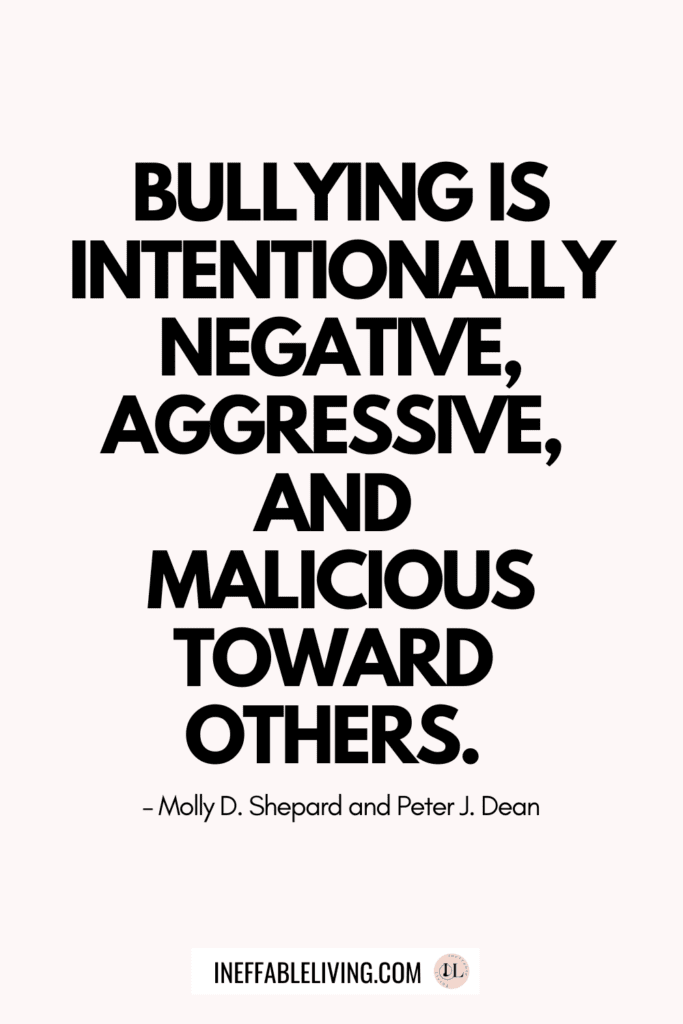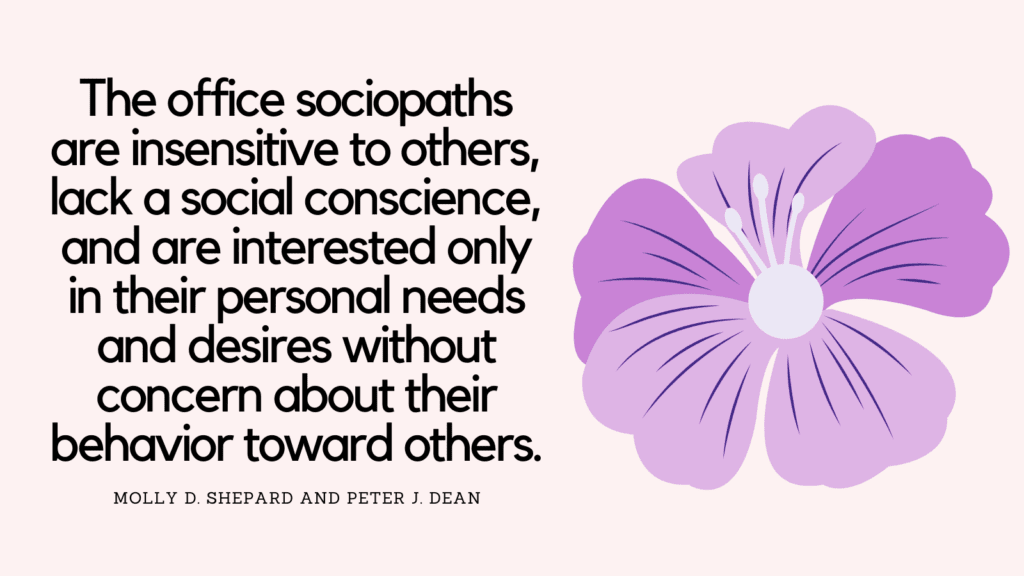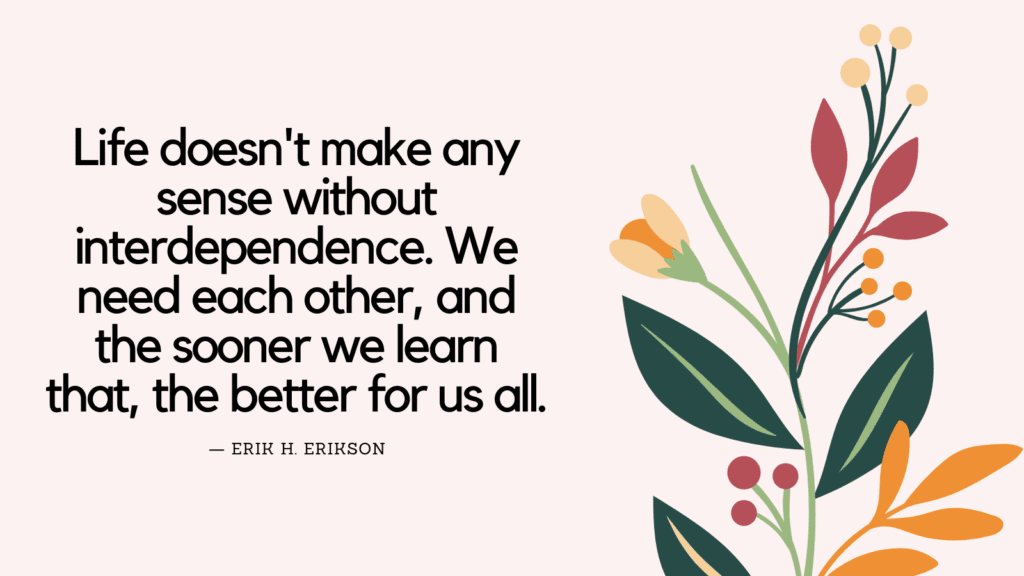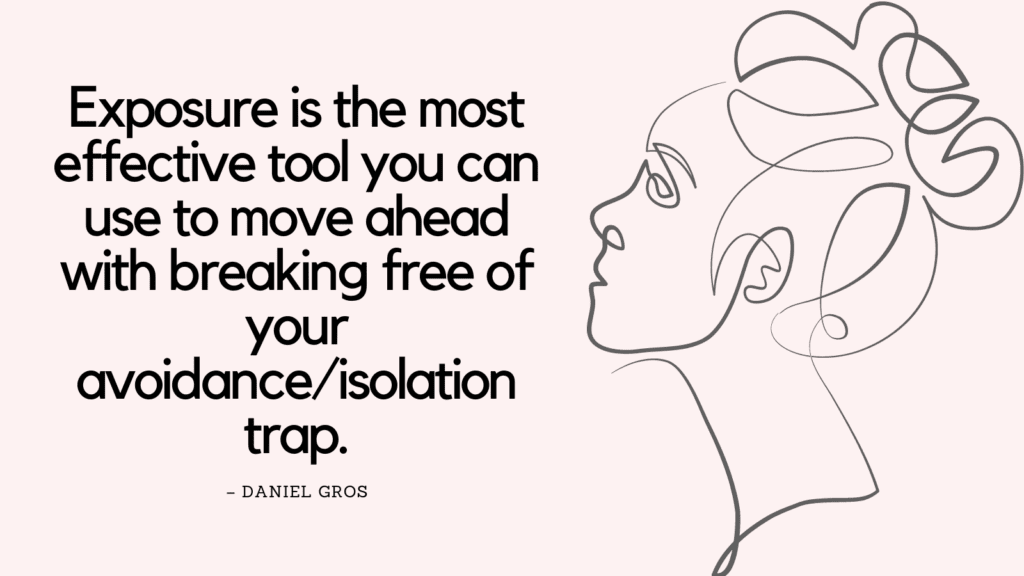This post contains some of the best workplace bullying quotes.
Going to work, most people expect to be able to carry out their workplace duties in a physically and emotionally safe environment.
Sadly, this is not always the case.
Many people have been bullied, are currently being bullied.
Even witnessing one of their colleagues being bullied is enough for some people to experience their workplace as changed forever.
Workplace Bullying
Workplace bullying is a personalized, often sustained attack on an individual employing emotionally punishing behaviors.
Such behaviors are meant to injure the victim’s self-esteem, self-confidence, and reputation or to undermine their competence to carry out their work assignments effectively.
Examples of bullying behaviors may include:
- Setting them up to fail in key work assignments.
- Taking actions that cause the quality of the victim’s work being lowered.
- Undermining their reputation at work personally and professionally.
- Excluding them from social events and workplace groups such as decision-making or information-giving forums.
- Scapegoating them for errors and mistakes they have not committed and/or are not responsible for.
- Repeatedly calling the victim by an insulting name to refer to them either behind their back, to their face or both.
- Making verbally abusive comments or remarks, using verbal aggression, shouting or swearing when speaking with the victim.
- Using jokes to humiliate the victim in front of their coworkers.
- Deliberately choosing to reprimand or put down the victim in front of their coworkers.
- Meddling with the victim’s personal possessions or office property such as removing or hiding their folders or files, using their computer without their permission.
Bullying should not be confused with effective management or leadership. The fact that the person using bullying behavior may have organizational authority over the person they are bullying does not justify their behavior.
Being on the receiving end of such attack can leave the person subject to it confused and full of self-doubt. They may expend so much of their energy and time trying to identify what it was they’ve done wrong that could have provoked such aggression.
Workplace Bullying Quotes
1. “Sixty-five million workers in the United States are affected by workplace bullying each year. The numbers are staggering—and on the rise—both in the United States and globally.” – Molly D. Shepard and Peter J. Dean
2. “Roughly one in four American workers have said that they’ve dealt with bullying at some point, according to a 2014 survey by the Workplace Bullying Institute (WBI).” – Molly D. Shepard and Peter J. Dean
3. “We believe, however, that where bullying is concerned, there is a strong connection between schools and the workplace.” – Molly D. Shepard and Peter J. Dean
4. “Bullying behaviors exhibited by youths in schools eventually become habitual and move into the workplace. Bullying learned at work is showcased at home to children and thus makes its way back into schools. It is a vicious cycle.” – Molly D. Shepard and Peter J. Dean
5. “The reality is that in the workplace, bullying takes on numerous different forms. Although 56 percent of workplace bullying is top down, that is, a manager bullies a subordinate, more than 33 percent of bullying is between coworkers and 11 percent is bottom up.” – Molly D. Shepard and Peter J. Dean
6. “What thrives in a workplace where bullying is tolerated is depression, anxiety, customer complaints, and litigation. The quality of work, productivity, employee loyalty, and engagement decline, and if the bullying is left unchecked, the bottom line of the organization is hurt.” – Molly D. Shepard and Peter J. Dean
7. “..workplace bullying behavior includes a wide range of overt and covert behaviors of intimidation.” – Molly D. Shepard and Peter J. Dean
8. “The office sociopaths are insensitive to others, lack a social conscience, and are interested only in their personal needs and desires without concern about their behavior toward others. They seldom feel guilt, and they do not think there is anything wrong in their bullying others. They see everybody else as outside of themselves. They are liars, gossipers, hypocrites, controllers, and boasters, and they act without impulse control.” – Molly D. Shepard and Peter J. Dean
9. “..bullying is intentionally negative, aggressive, and malicious toward others who often have talent or expertise but who are otherwise less powerful than the bullies.” – Molly D. Shepard and Peter J. Dean

10. “Bullying is not an occasional or infrequent expression of frustration. Rather, it is meant to harass, coerce, humiliate, demean, dominate, exclude, and/or subjugate other people. It purposely diminishes the targets’ ability to work and redirects their energy toward being on the defense.” – Molly D. Shepard and Peter J. Dean
11. “Most important, the effect of the bullying doesn’t stop with the targets. It influences others in the workplace and can demotivate or instill fear, anxiety, stress, and a sense of powerlessness throughout the culture, which can, in turn, inhibit loyalty, creativity, and positive energy.” – Molly D. Shepard and Peter J. Dean
Related: Covert Verbal Abuse: What Is It & How To Recover From Verbal Abuse
12. “Today, most employers tend to deny, discount, or rationalize bullying behavior—in because of a lack of understanding of the problem and how to deal with it.” – Molly D. Shepard and Peter J. Dean
13. “Although bullies have existed since the beginning of time, their numbers began increasing in U.S. workplaces when layers of management were introduced at the start of the era of mass production.” – Molly D. Shepard and Peter J. Dean
14. “Bullies are pervasive. They demean, diminish, defame, belittle, lie, spread rumors, act selfishly, and target individuals repeatedly. Bullies have great difficulty listening, empathizing, attending, and showing respect to others in interpersonal exchanges. They usually have their own selfish agenda in mind and not the agenda of the business or company at which they work. They feel no remorse if their actions, such as consistently badgering subordinates, spreading false gossip, outright lying, blocking colleagues from getting credit for work, and crushing someone in a conversation, cause emotional harm.” – Molly D. Shepard and Peter J. Dean
15. “We have found bullies in the workplace to fall into four common types: the Brutes, who use aggressive, antisocial, and even threatening behavior to keep others in line; the Braggarts, who are self-adoring narcissists who focus attention on themselves; the Blockers, who denigrate and always finds fault with the ideas of others; and the Beliers, who besmirch others behind their backs with false statements, rumors, deceptions, and innuendos.” – Molly D. Shepard and Peter J. Dean
16. “Bullying is grounded in a need for self-gratification to shore up feelings of fear; insecurity; low self-esteem, self-worth, and self-confidence; poor interpersonal skills; and a lack of maturity and confidence.” – Molly D. Shepard and Peter J. Dean
Related: How To Break The Cycle Of Abuse? Top 10 Powerful Strategies To Stop Being An Abusive Person
17. “The bullies’ skewed persona has emerged from their basic temperament, their past life experiences, and the cultural influences to which they were exposed. It is also very possible that they have endured a traumatic experience in the past that has had a major influence on them.” – Molly D. Shepard and Peter J. Dean
18. “When bullying occurs, the bully is acting out of his own self- interest. The bully is unable and not mature enough to assess his own feelings of insecurity, much less the sensitivities of the target, and he believes his negative impact on the target is correct and justified. Moreover, he may feel that this is the best way to inspire and motivate others.” – Molly D. Shepard and Peter J. Dean
19. “We want to eliminate bullying from the workplace altogether and create a workplace that allows for optimal productivity and true individual development. The idea that one person can bully another and get away with it is unacceptable in this day and age. The overall purpose of dealing with bullies in the workplace is to create an environment where certain positive behaviors exist and bullying behaviors don’t. The individuals who stand up to the bully must also model the behaviors necessary to create a bully-proof workplace.” – Molly D. Shepard and Peter J. Dean
20. “Standing up to your bully is a personal challenge. If it goes well, you will see the positive results right away. You will feel relief from an unjust burden and feel good about your growth as a successful businessperson.” – Molly D. Shepard and Peter J. Dean
21. “Bullying in the workplace is a critical issue that is growing in scope within the corporate world. Bullying is the intentional mistreatment of others that can cause physical and/or psychological harm. It is present in all industries and at all levels, and it can have a negative impact on the bottom line.” – Molly D. Shepard and Peter J. Dean
Related: Healing From Emotional Abuse In 12 Practical Steps
22. “Workplace bullying is about: A personalized, often sustained attack on one colleague by another colleague using behaviors which are emotionally and psychologically punishing.” – Aryanne Oade
23. “The intention of the workplace bully is twofold. Firstly, to select a colleague against whom they will mount a personalized campaign; and secondly, to employ a range of behavioral tactics which might result in coworkers joining in that campaign either because they are duped into doing so or because it serves their individual interests to do so. Some bullies are satisfied with doing the first of these two things only.” – Aryanne Oade
24. “Many people subject to workplace bullying wrongly assume that they have made an error, or have overlooked something important or deserve some of the flak they are getting. Others expend energy, time and effort worrying, trying to identify what it was they’ve done wrong and trying to identify what actions they’ve taken that could have provoked such aggression. Invariably they can’t find very much at all and sometimes they can’t find anything at all.” – Aryanne Oade
25. “There are many, many behaviors which, given the definition of workplace bullying presented above, fit the bill. Remember that the measure of whether a particular behavior does or does not constitute an example of workplace bullying lies with the motivation of the bully in employing that behavior.” – Aryanne Oade
26. “Many people affected by workplace bullying are bewildered by the experience. It often comes out of the blue and, being unexpected, can leave them shaken and flatfooted or simply overwhelmed right from the off. Some people subject to workplace bullying are so disorientated by the unforeseen aggression they receive that they are defeated by it before they’ve had time to assimilate what is happening to them. Others recognize it for what it is but simply don’t know how to deal with such a relentless, personalized attack having had neither the training in how to do so nor a similar experience from which to draw effective lessons.” – Aryanne Oade
27. “The bully makes the relationship about power: their power over you. They use behavior which is dominating, dictatorial and intimidating. They use fear to control you and don’t want their working relationship with you to be characterized by partnership or collaboration. They want to hold sway over you. They want to control your behavior and they think they are entitled to hold as much power in the relationship as they can.” – Aryanne Oade
28. “Bosses who bully have a degree of organizational authority which gives added impetus to their bullying activity and which makes them mightily intimidating figures in the workplace.” – Aryanne Oade
29. “Faced with these realities many people subject to workplace bullying use behavior which is outwardly compliant, accommodating and submissive at the time they are being bullied. They are unaware that these are the very reactions that workplace bullies thrive off.” – Aryanne Oade
30. “However, even if it doesn’t feel like it, handling workplace bullying well is about responding effectively to a series of individual instances of bullying behavior; and, in some cases, it is about responding effectively to only one incident of bullying behavior. Seen in this light it might appear to be a more manageable experience.” – Aryanne Oade

How to Manage Workplace Bullying?
Managing workplace bullying can be challenging, but there are steps you can take to address and resolve the issue. Here’s how:
1. Recognize the bullying behavior: It’s important to be able to identify what constitutes bullying in the workplace. Bullying can include verbal abuse, threats, intimidation, exclusion, or any other behavior that creates a hostile environment.
2. Document incidents: Keep a record of each instance of bullying, including dates, times, locations, people involved, and descriptions of what happened. This documentation will serve as evidence if you need to take further action.
3. Try to understand the situation: Assess whether the behavior is unintentional, a result of conflicts, or if it’s deliberate bullying. This understanding can help inform your approach to resolving the issue.
4. Speak up: Address the bully directly if you feel comfortable doing so. Calmly express how their behavior is affecting you and request that they stop. If you’re unable to confront them or if the behavior continues, involve others.
5. Seek support: Talk to a trusted colleague, supervisor, or HR representative about the situation. They can offer advice, guidance, and support throughout the process.
6. Follow company protocols: Familiarize yourself with your organization’s policies regarding workplace bullying. Follow the established protocols for reporting incidents and escalate the matter if necessary.
7. Engage in mediation or conflict resolution: If appropriate, suggest mediation or conflict resolution sessions with the bully, facilitated by a neutral third party such as HR. This can provide an opportunity for open communication and finding a resolution.
8. Take care of yourself: Coping with workplace bullying can be emotionally draining, so prioritize self-care. Engage in activities that reduce stress, maintain a healthy work-life balance, and seek support from friends, family, or a therapist if needed.
Conclusion
Resolving workplace bullying may take time, but it’s crucial to address the issue for your own well-being and the overall health of the work environment.

References
- Portions of this article were adapted from the book The Bully‑Proof Workplace, © 2017 by Molly D. Shepard and Peter J. Dean. All rights reserved.



